# macOS Installation Instructions
# Brief Instructions
Perform these steps to install Excel to Graphviz on macOS
Use Homebrew (opens new window) to download and install Graphviz using the Install command:
brew install GraphvizOpen a terminal window.
Run the command:
sudo dot -cto register the Graphviz plugins.
Confirm Graphviz is working. Run the command
dot -Vto emit the version of GraphvizDownload file
RelationshipVisualizer.zipfrom SourceForge (opens new window)Unzip file
RelationshipVisualizer.zipDetermine where the
dotcommand is installed. Issue the command:which dotIf
dotis installed in/usr/local/bin/dot, then proceed with the next step, otherwise, edit the fileExcelToGraphviz.applescriptand update the path
/usr/local/bin/dotat the top of the script to the match the path emitted by the
which dotcommand.Copy the file
ExcelToGraphviz.applescriptto folder
\~/Library/Application Scripts/com.microsoft.ExcelStart Excel, and open the file
Relationship Visualizer.xlsmEnable macros, and grant permissions when prompted
Save the file as a template for creating future spreadsheets.
# Detailed Instructions
# Install Graphviz
The Graphviz Download Page (opens new window) offers 2 options for installing Graphviz, either by MacPorts or Homebrew.
I used homebrew to install Graphviz by following the instructions at this site https://formulae.brew.sh/formula/graphviz (opens new window) .
A video capture of a homebrew Graphviz installation can be viewed at https://www.youtube.com/watch?v=zRiUC82AnCk (opens new window)
# Configure Graphviz plugins.
This is an important step which must not be skipped. No messages are written when the command executes; the screen will look as follows:
You must have installer write privileges to configure the Graphviz plugins.
- Open a
Terminalwindow - Enter the command
sudo dot -c - Enter the administrator password when prompted
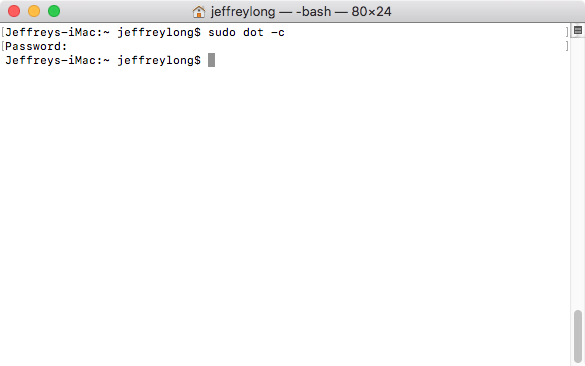 |
|---|
# Confirm Graphviz version
While you still have the terminal window open, issue the command dot -V (uppercase V). If Graphviz is properly installed, it will emit a version number such as 2.44.1.
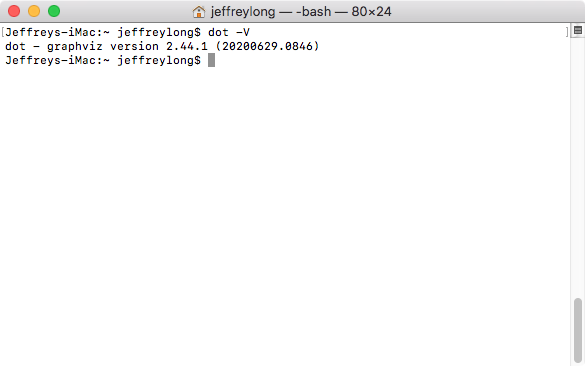 |
|---|
To see the list of configured plugins type the command
dot -v
where the -v is lowercase. The screen will appear as follows:
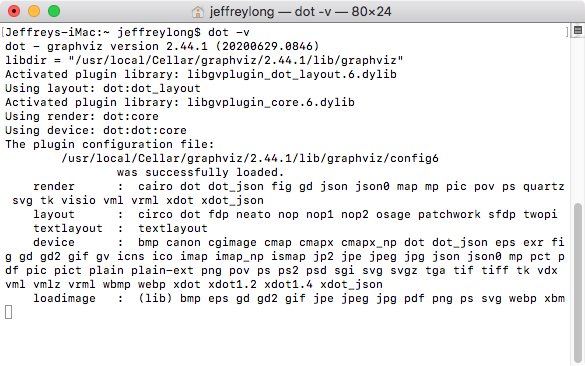 |
|---|
At this point Graphviz is waiting for more input. Hitting the Command key + .(dot/period) key will break you from the dot program.
To see the list of command line options you can enter the command
dot -?
The screen will appear as follows:
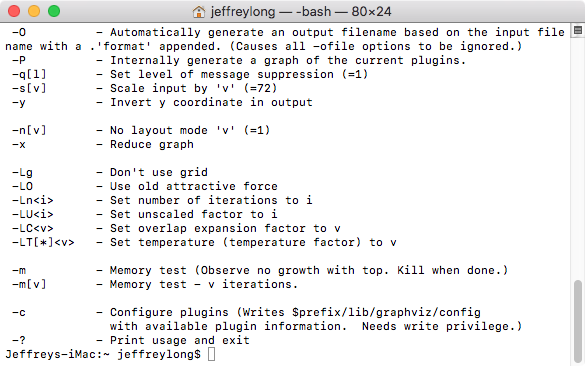 |
|---|
Congratulations! Graphviz is installed properly.
# Download file RelationshipVisualizer.zip from SourceForge.net
Excel to Graphviz is exclusively hosted on SourceForge.net. If you obtained a copy from any source other than direct download from SourceForge.net, then I suggest that you download the latest version from at https://sourceforge.net/projects/relationship-visualizer/ (opens new window)
# Unzip file RelationshipVisualizer.zip
The contents of “RelationshipVisualizer.zip” may be stored in any location. The zip file contains the macro-enabled spreadsheet “Relationship Visualizer.xlsm”, the corresponding Apple Script file ExcelToGraphviz.applescript, user documentation, samples, and license files.
The file ExcelToGraphviz.applescript must be installed in a specific location per Microsoft’s sandbox rules. This location is explained in future steps.
# Edit file ExcelToGraphviz.applescript
Update the path to the Graphviz dot command in the file ExcelToGraphviz.applescript (if necessary).
Homebrew installs the dot command in the folder /usr/local/bin. You can enter the command
which dot
in the terminal window to see where dot is installed.
If you get a response other than /usr/local/bin/dot, then you must edit the file ExcelToGraphviz.applescript and change the path in the command on line 2 from /usr/local/bin/dot to the path where dot is installed on your Mac.
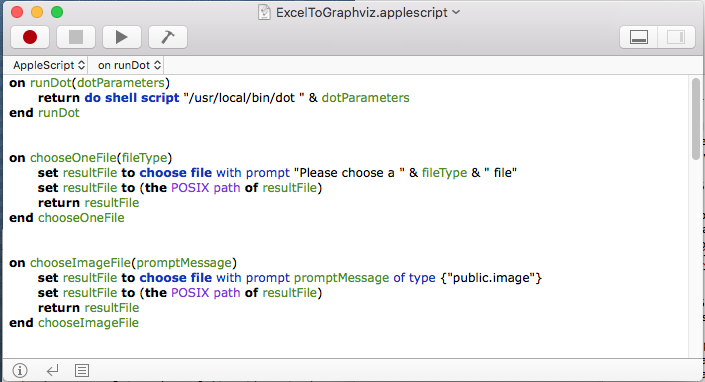 |
|---|
# Copy Applescript script to sandbox folder
Copy file ExcelToGraphviz.applescript to folder ~/Library/Application Scripts/com.microsoft.Excel
Now the script file is ready and tested we must copy it into the correct location. Follow the steps below to copy and paste it into this exact location.
- Open a Finder Window
- Hold the
Altkey and clickGoin the Finder menu bar - Click
Library - Click
Application Scripts(if it exists; if not create this folder) - Click
com.microsoft.Excelif it exists; if not create this folder (note: Capital letterE) - Copy the file
ExcelToGraphviz.applescriptto the foldercom.microsoft.Excel
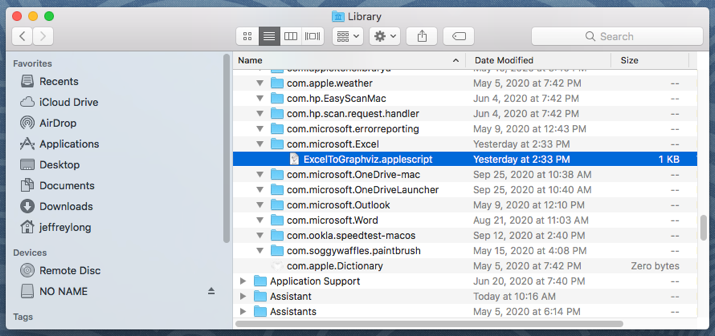 |
|---|
Microsoft Excel Sandboxing Explained
Unlike prior versions of Office apps that support VBA, Office 2016 for Mac apps are sandboxed. Sandboxing restricts the apps from accessing resources outside the app container. This affects any add-ins or macros that involve file access or communication across processes.
Earlier versions of Office for Mac included a command called MacScript that supported inline AppleScripts. Although that command still exists in Office 2016 for Mac, MacScript is deprecated and its powers have been reduced. The MacScript command cannot invoke other applications, such as Finder, in Office 2016 for Mac due to the new sandbox rules.
Microsoft added a new VBA command AppleScriptTask that accesses and runs an AppleScript file located outside the sandboxed app. This new approach is not as convenient:
- With the
MacScriptfunction the commands needed to run Graphviz’s dot command could reside in the Excel file itself, while with theAppleScriptTaskmethod it has become necessary to distribute anAppleScriptscript file. - Furthermore, this
AppleScriptfile must be placed in a folder location specified by Microsoft’s sandbox rules on the user’s system to have permission to run. This sandbox requirement requires a user interaction the first time to place the script in the required folder location~/Library/Application Scripts/com.microsoft.Excel
# Open the file Relationship Visualizer.xlsm
Open the file Relationship Visualizer.xlsm in Excel by double clicking on the file Relationship Visualizer.xlsm provided in the zip file
# Enable Macros
Excel to Graphviz performs its work using VBA macros. When you launch the file, you will receive warnings of the macros and must give permission for the macros to run.
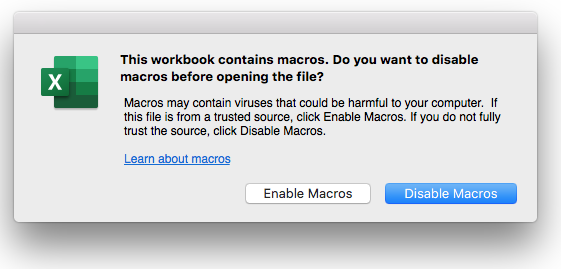 |
|---|
# Save Relationship Visualizer.xlsm as a template.
Once you enable the macros, the full spreadsheet appears as:
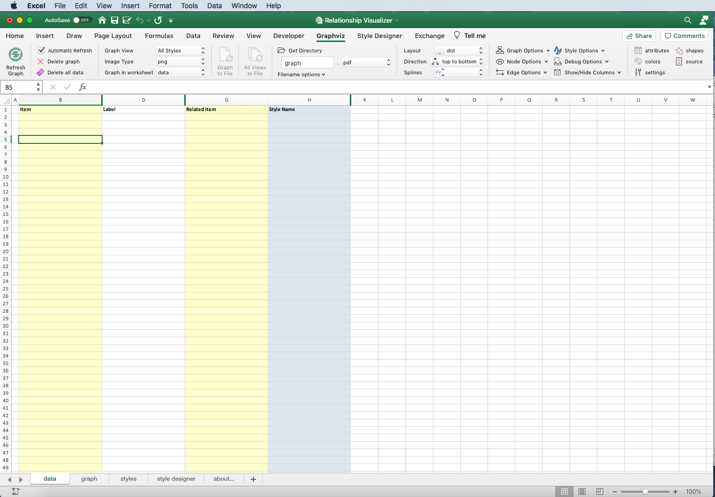 |
|---|
Perform a "File -> Save As" operation. Save the workbook as a template so you can use the template to create more workbooks instead of starting from scratch. A template allows you to avoid having to make a copy of a file and clearing out old content.
From the File menu, select Save as Template…
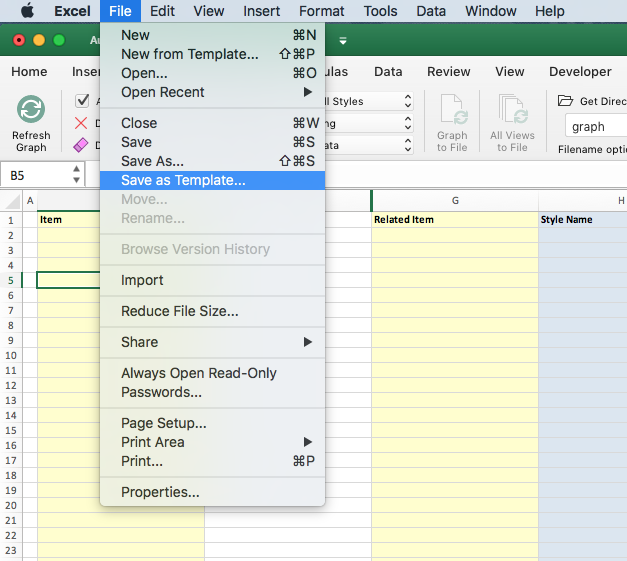 |
|---|
When the file save dialog appears, provide a “Save As” name (e.g., Relationship Visualizer) and specify the file format as “Excel Macro-Enabled Template (.xltm)”.
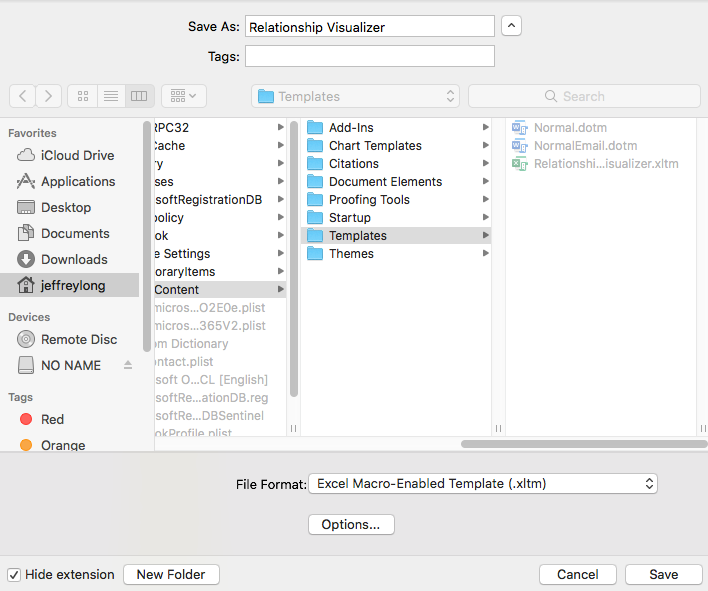 |
|---|
Note that Excel automatically specifies the Microsoft Office Templates directory.
Like this tool? Buy me a coffee! ☕ (opens new window)
